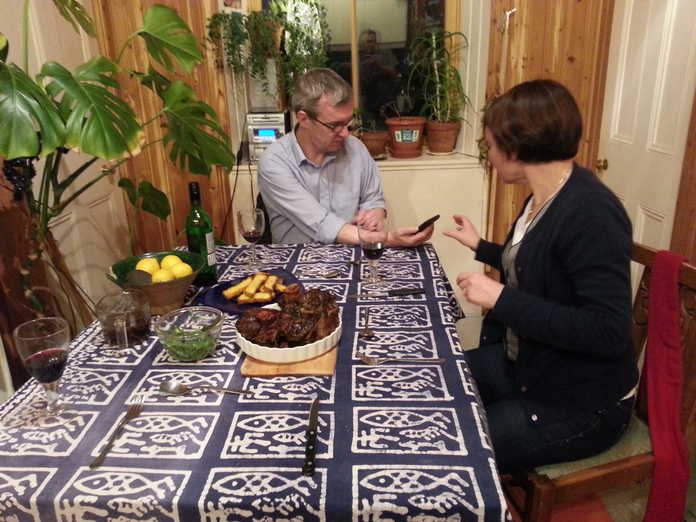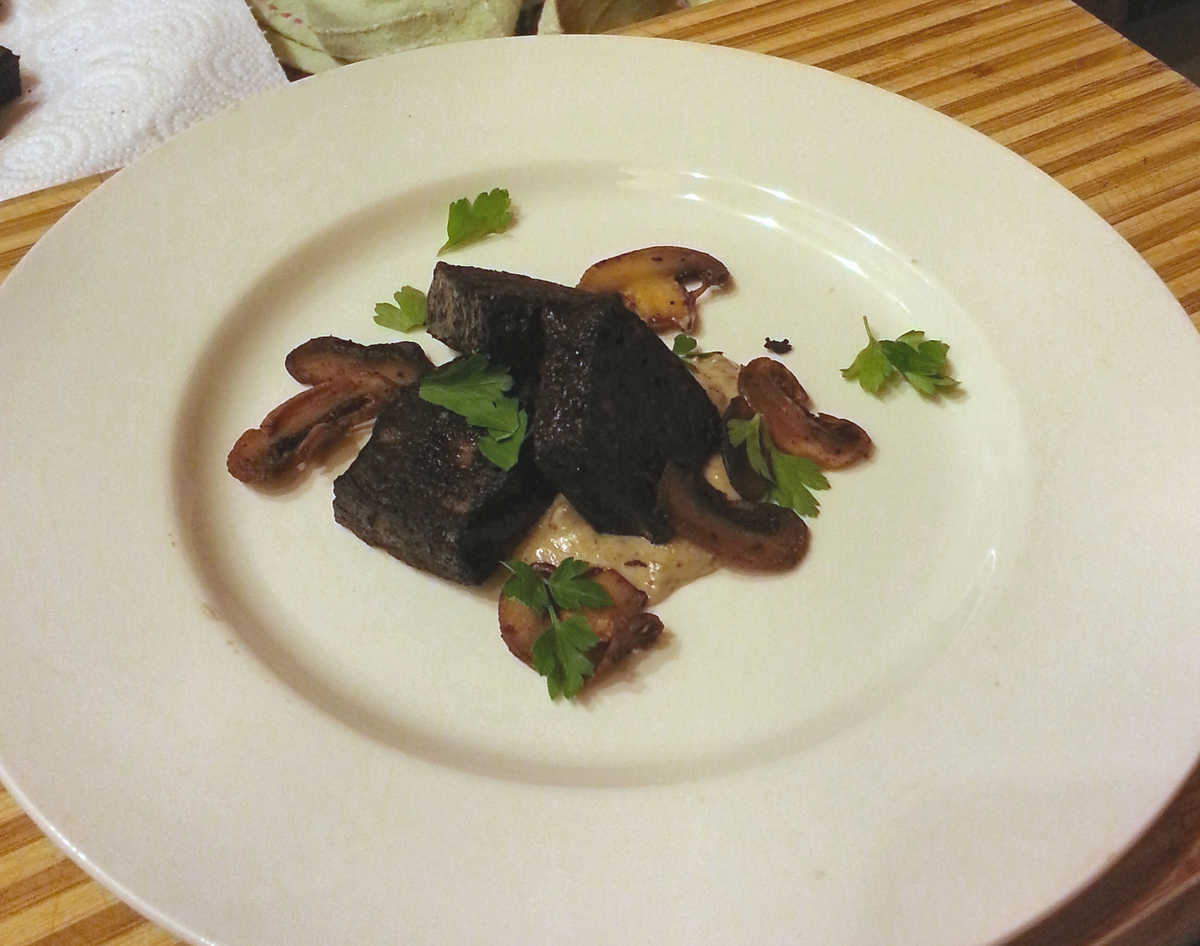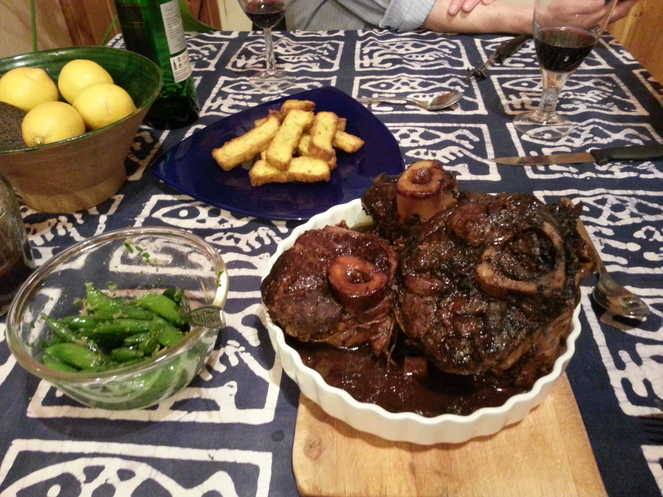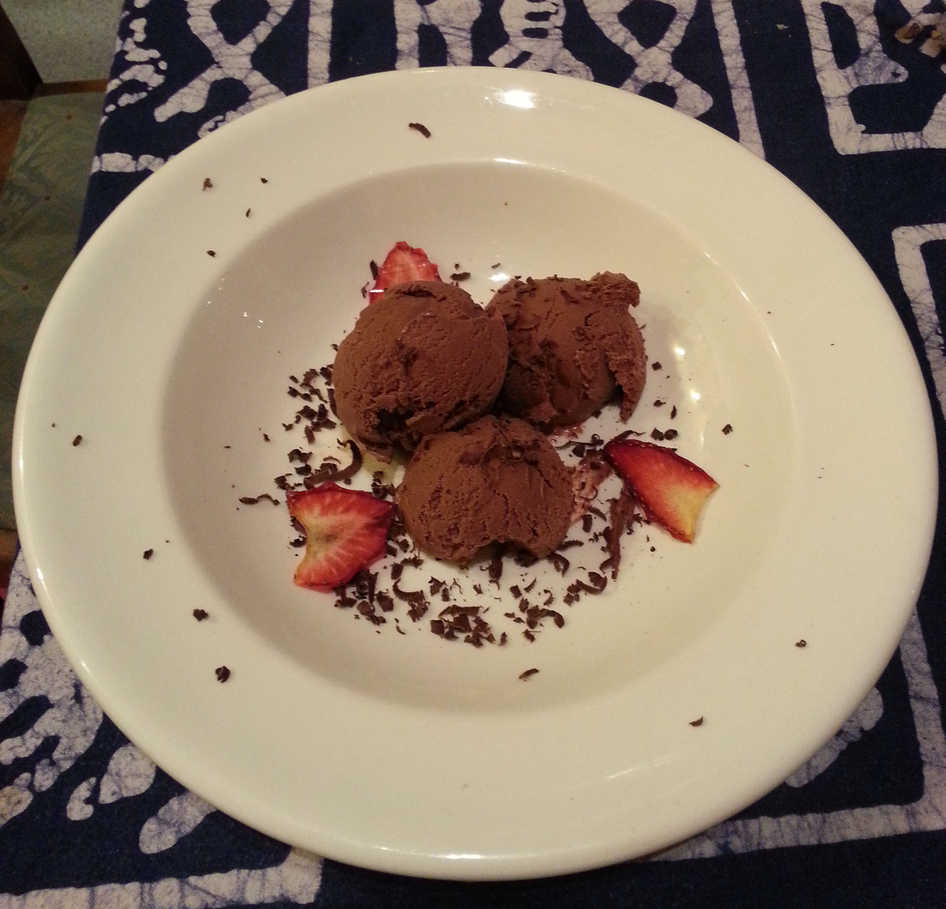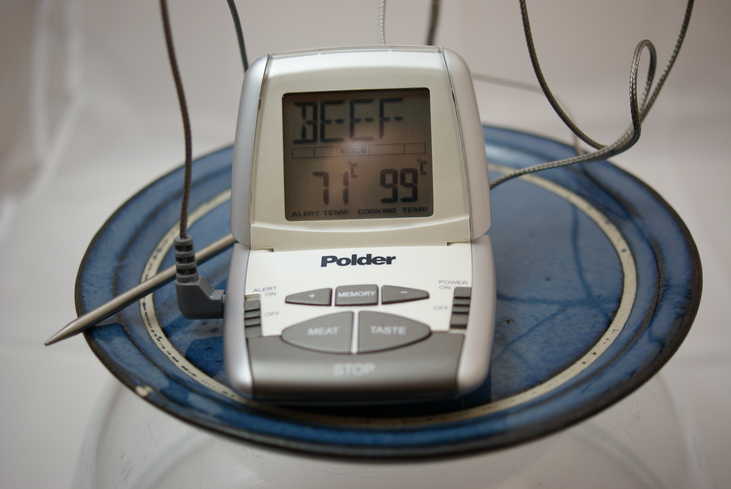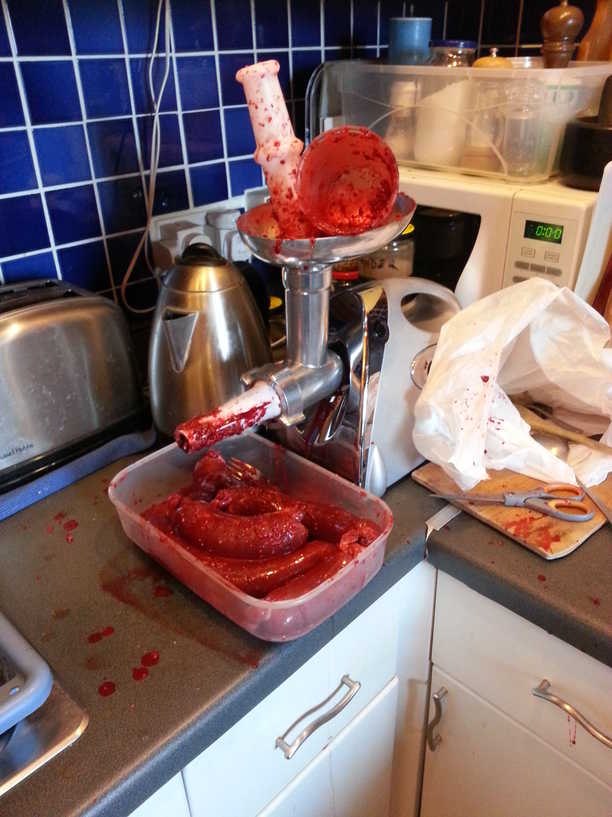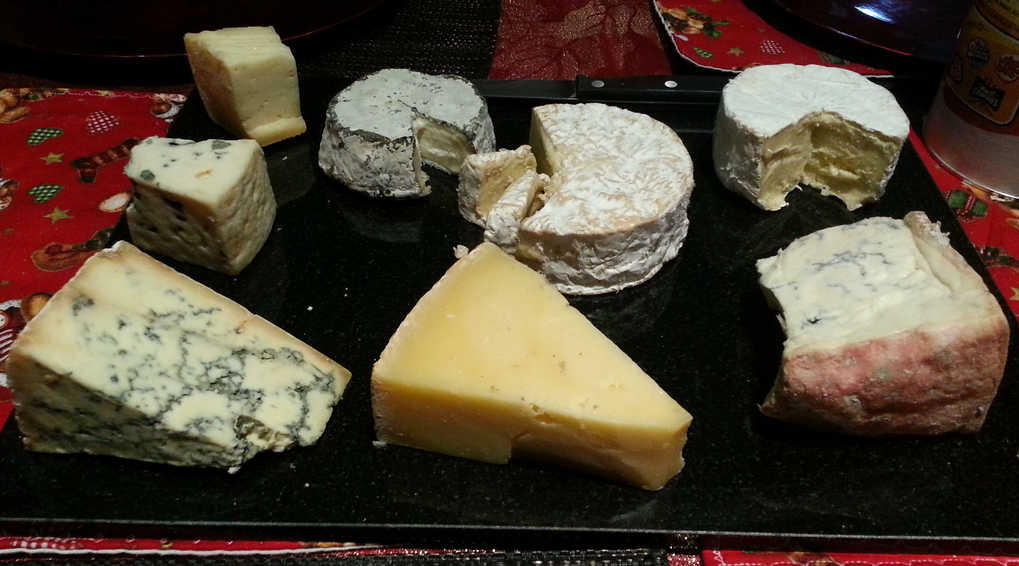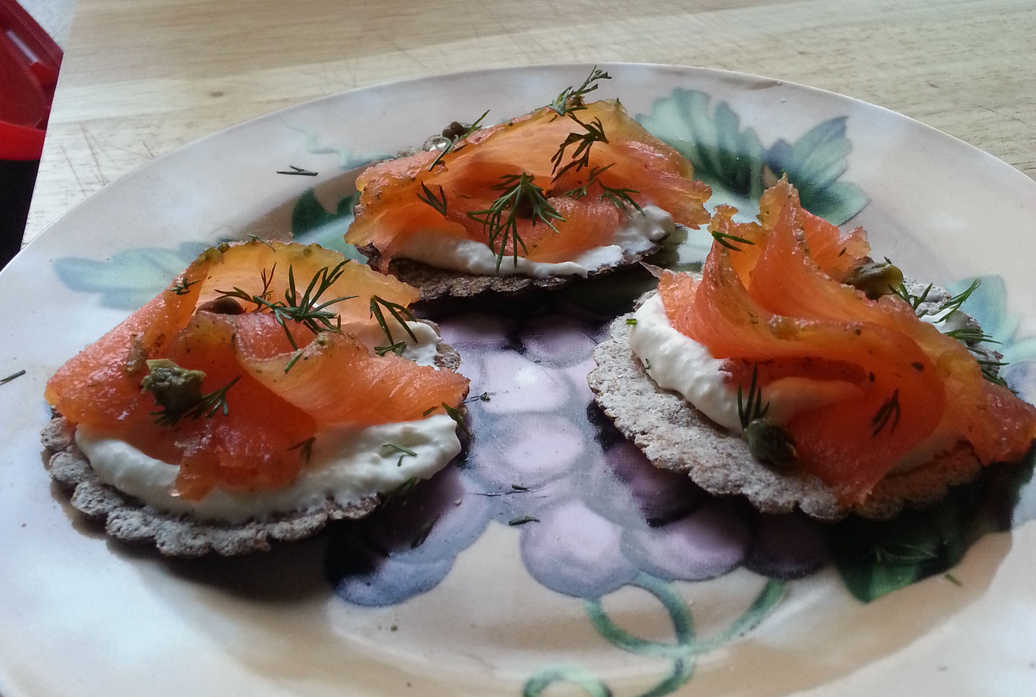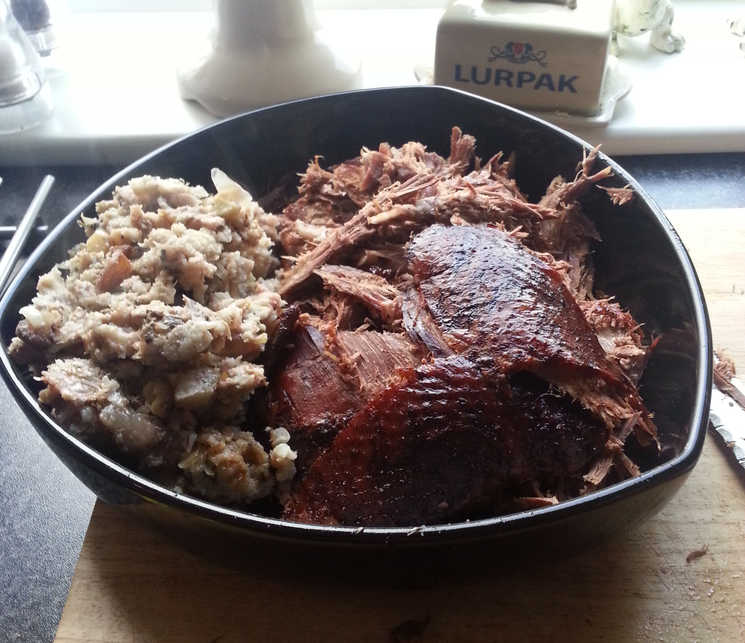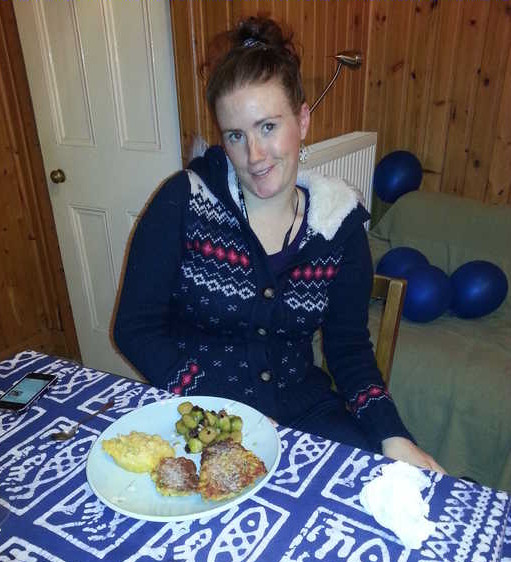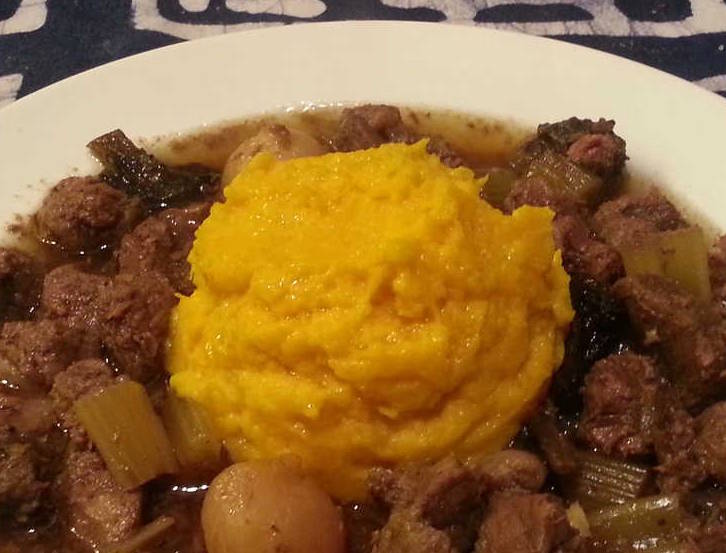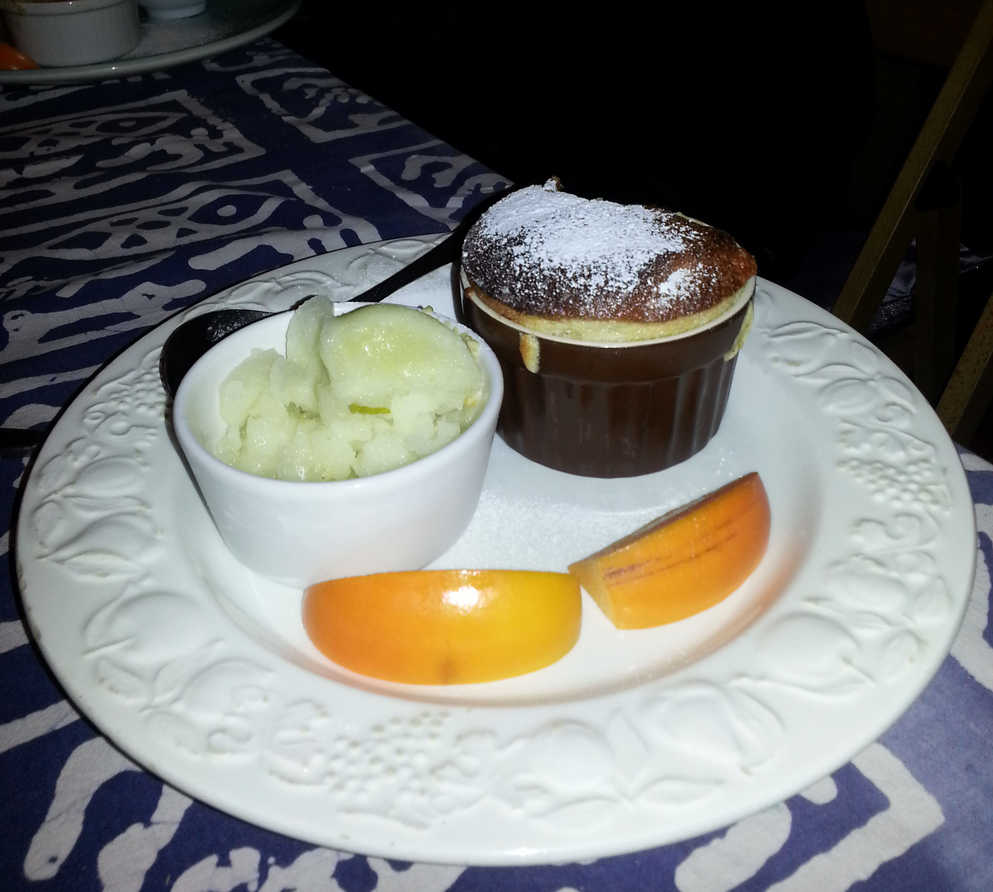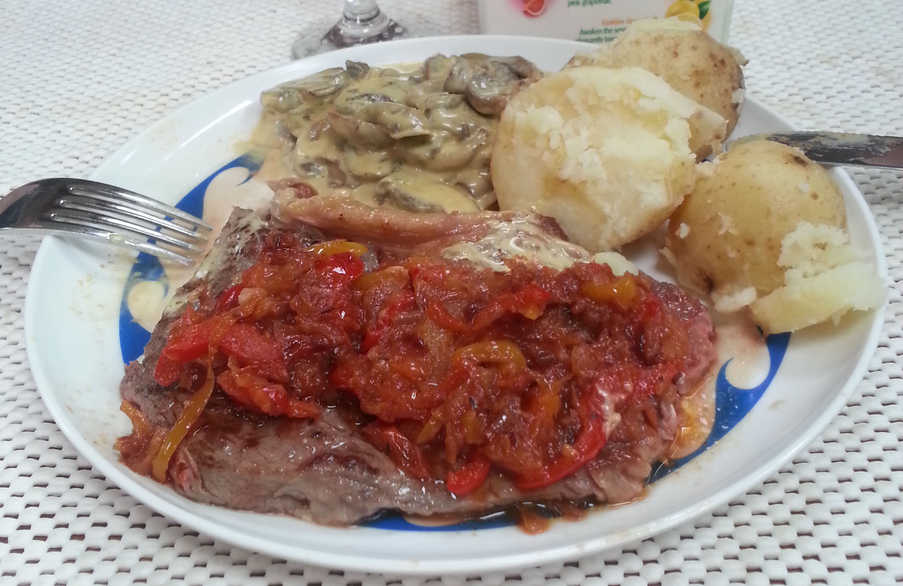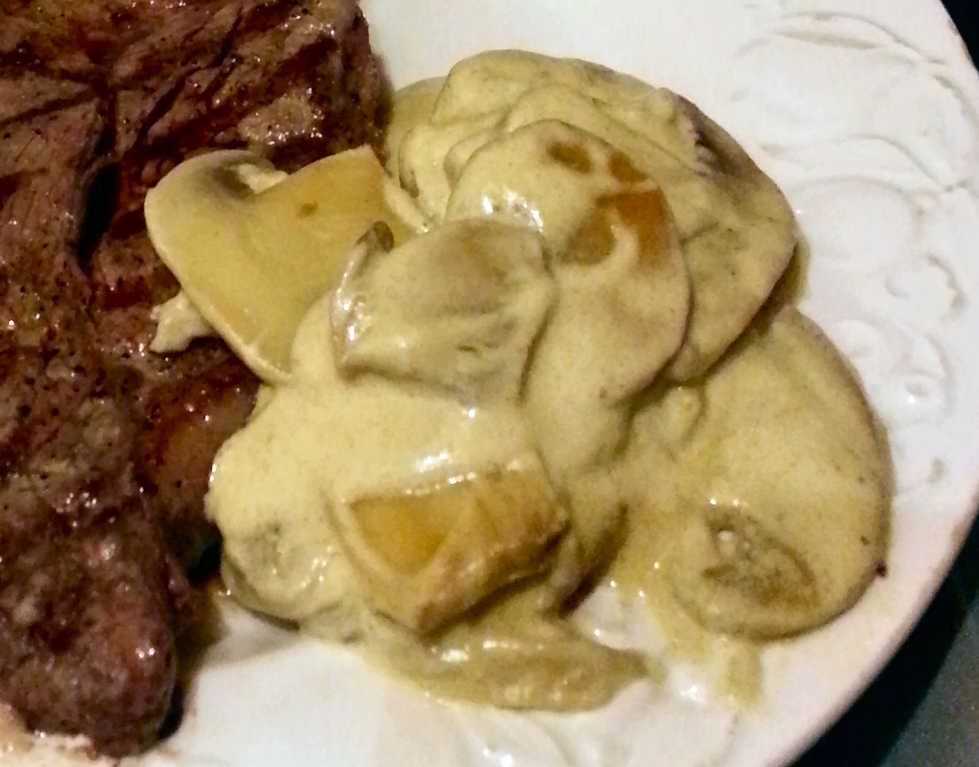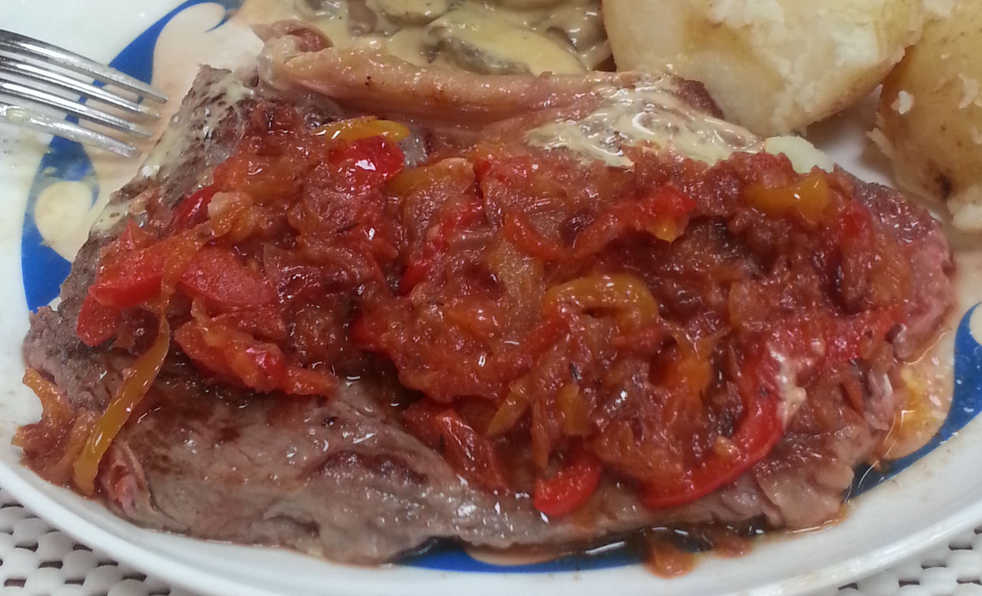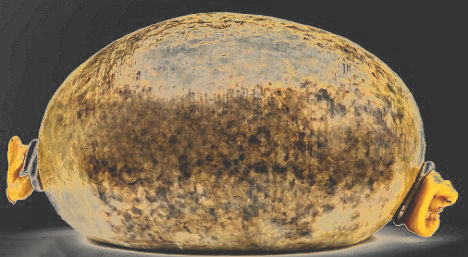
Rosso Buco

I've been wanting to do a nice rich red-wine pot-roast in my slow cooker for a while. When my butcher offered me a whole monster veal shank for £25 I jumped at it. Despite his scepticism about my choice of wine colour (Osso Buco is more properly braised in white wine) the more I admired the glorious meat, the more I convinced myself it would take a good red wine. It was a surprisingly hefty joint - weighing in around 3kg, and the flesh quite rich and dark, so I'm guessing it was an older calf than that usually used for Italian ossobuco but ideal for taking the stronger flavour of red wine. Which is handy because I happened to have several leftover bottles lying around begging to be used up.
Aidan and Jude very kindly came over to help out with eating some of my black pudding
(this time some of the baked loaf version I'd cut into sections and frozen)
and to lend a hand with the monster shank. Lucky for me or I'd be dying of rosso buco poisoning about now.
They also made handy guinea pigs for my latest ice cream innovation - avocado and chocolate flavour!
Apart from the hours of slow-cooking my monster shank, most of the meal prep work was done the night before and the remainder was pretty easy to turn out for dinner.
I served the fried homemade black pudding on a creamy mushroom sauce, with a little strawberry-dressed mixed leaf salad and some red onion.
Since my monster cuts of shank were too intimidating to serve individually I just piled them into a quiche dish and dressed them with the strained cooking liquor for the guests to help themselves.
They seemed well satisfied :)
Though I think they approached dessert with some justifiable trepidation (memories of my crab ice cream still too raw for comfort) they seemed pleasantly surprised by the result. I'm not sure it's actually better than plain old chocolate, but it's certainly not worse. Plus you get to watch your guests faces when you tell them it's avocado and chocolate flavour.
And you can't put a price on that!
Cheers!
They also made handy guinea pigs for my latest ice cream innovation - avocado and chocolate flavour!
Apart from the hours of slow-cooking my monster shank, most of the meal prep work was done the night before and the remainder was pretty easy to turn out for dinner.
I served the fried homemade black pudding on a creamy mushroom sauce, with a little strawberry-dressed mixed leaf salad and some red onion.
Since my monster cuts of shank were too intimidating to serve individually I just piled them into a quiche dish and dressed them with the strained cooking liquor for the guests to help themselves.
They seemed well satisfied :)
Though I think they approached dessert with some justifiable trepidation (memories of my crab ice cream still too raw for comfort) they seemed pleasantly surprised by the result. I'm not sure it's actually better than plain old chocolate, but it's certainly not worse. Plus you get to watch your guests faces when you tell them it's avocado and chocolate flavour.
And you can't put a price on that!
Cheers!
menu
Starter
Homemeade Black Puddings with a mushroom sauce
Main
Rosso Buco
Blanched Sugar Snap Peas dressed with Gremolata
Fried Herb Polenta
Dessert
Avocado Chocolate Ice Cream
Homemeade Black Puddings with a mushroom sauce
Black pudding. AGAIN!
Served with a strawberry-dressed salad.
Served with a strawberry-dressed salad.
Main
Rosso Buco
Blanched Sugar Snap Peas dressed with Gremolata
Fried Herb Polenta
Dessert
Avocado Chocolate Ice Cream
Yep, you read that right!
Comments (0)
Un-Burns Supper

I'm skipping the whole Burns Supper extravaganza this year, mainly due to laziness and a lack of guts :)
However, I do have a fantastic concept for next year, and so I'm here to stake my claim to it: wrapping the haggis in gold leaf!
Extensive research reveals no prior art.
See that Golden Haggis? I invented that...
Whilst I'm here inventing things I've decided we need a Scottish alternative to the fasting period Lent. I'm calling it Bent - it's when we feast on porridge and haggis. And whisky. For forty days.
So anyhoo, I invited Flora to share my Un-Burns supper of black pudding and salad. I figured that's about as un-haggis as you can get whilst keeping to the spirit of the thing. Plus it's a salad - so it's dead healthy too!
In the process of making the salad I discovered an excellent combination of flavours for marinating mushrooms which meant that I ended up with a surfeit of marinated mushrooms, which led inexorably to disappointingly mediocre exotic stew. And a surprisingly well matched Caribbean-styley pumpkin mash handily using up a few more of my leftover pumpkins. Yes I still have leftover pumpkins. Yes they're still edible. They've been living in my icebox spare room.
Some days it just seems the cooking will never end.
Which leads me back to the black pudding. Though I bought the ones for our Un-Burns Supper, I've been wanting to have a go at making some for ages, particularly since I came to grips with making my own sausages. So I finally motivated myself to actually do it, having chased down a butcher willing to give me a bucket of blood. Unfortunately he was only willing to give me a very large bucket of blood. Which is soooo much blood. I decided to be creative with the puddings I made and concocted a chocolate and an apple flavoured variety to serve as the starter for a particular meat-oriented (which of mine aren't?) bloody non-romantic Un-Valentine dinner I had in mind. Well, when you get to my age...
Of course the bloody puddings might have come out a bit less bloody and a bit more black if I hadn't invested in a bloody useless comedy meat thermometer courtesy of
Polder
which works just long enough for you to throw away the receipt before displaying only joke temperatures.
I blame my equipment.
And no, it isn't an accident, I've tried two of them and they both do the same thing.
Fool me once - shame on you; fool me twice - I'm a fucking idiot!
Anyway - I won't be making black puddings again anytime soon, fun though it was I ended up with blood everywhere. And it took hours to hose off. Also now I've got yards and yards of black pudding to eat.
I've enticed friends around to share them.
I've given them away at work.
I've filled my freezer with them.
I've created a (quite tasty) mixed-vegetable white mustard sauce to eat with them.
I'm bloody sick of them!
Fool me once - shame on you; fool me twice - I'm a fucking idiot!
Anyway - I won't be making black puddings again anytime soon, fun though it was I ended up with blood everywhere. And it took hours to hose off. Also now I've got yards and yards of black pudding to eat.
I've enticed friends around to share them.
I've given them away at work.
I've filled my freezer with them.
I've created a (quite tasty) mixed-vegetable white mustard sauce to eat with them.
I'm bloody sick of them!
Golden Haggis
Haggis covered in gold leaf
meat main
Ha! I'm staking my claim to this one.
Job Done!
Job Done!
Ingredients
- haggis
- gold leaf
Cook your haggis.
Paste it with gold foil.
Serve.
Paste it with gold foil.
Serve.
I wonder if you could get silver foil into the neeps and tatties to go with?
Cupboard Love

Over Christmas my host Suzannah and I somehow got into an argument about vinegar (only in my life eh). I think I may have made a tiny criticism of the Kissantell's meagre range (she was proud to offer both malt and Balsamic), upon which she demanded photos of my cupboards.
So as requested here you go, enjoy:
Pear Noel

Christmas with the Kissandtells.
Now that Mum's gone on to better things, it's down to Brother Kurt and his oddly-named family to carry on our venerable seasonal traditions. It turns out that Mum left some big boots to fill. Mainly with baking, (Thanks Suzannah!) but also ample sidepockets of goose ordering, Pringles stocking, and pork roasting.
Christmas Eve ritual: curry and a roast pork sandwich. Plus I really like Pringles. So sue me.
Fortunately brother Kurt (and his little helpers) took care of all that,
which just left me with the onerous task of actually having all my presents wrapped by Christmas Eve,
and not relying on being able to turn up late and spend the rest of the holy night wrestling with paper and sticky tape. Humbug!I blame the kids. The Kissandtells are sadly afflicted with children, and as any fule kno: children ruin Christmas. Ah well, I suppose time heals all wounds. Eventually!
As usual I come bearing gifts of starter and stuffing and, new for 2013, the cheese board.
This Christmas I will be mostly stuffing with Pear and Sage. And since we don't have to cater for any pesky tarians this year it's also mostly meat :) It turned out quite well actually, particularly the extra dish of it we roasted separately. I'm slowly coming to accept that stuffing which comes out of the goose is doomed to mediocrity - it's always greasy, soggy, and underwhelming. Whereas baked on its own you can get a nice crunchy topping with plenty of good flavour and texture within.
Sigh, I suppose you can't fight tradition. Greasy, soggy stuffing it is.
My gravlax on rye crispbreads starter went down pretty well: just smear the crispbreads with a dose of crème fraîche horseradish sauce, pile on thinly sliced gravlax, top with a scattering of dill fronds and a few capers, and serve with a lime wedge.
Incidentally - the difference between sour cream and crème fraîche?
The French stuff is thicker, richer and less sour than the British version.
Much like their women.
Things we learned this Christmas:
- Kurt's fan-assisted oven cooks a goose quite a bit quicker (and drier) than Mum's old gas oven, so our 10lb (before stuffing) goose was ready in 3½ hours at 165°C rather than the predicted 4¼. If we had been paying attention we would have wrapped it in tin foil earlier to limit the browning, and taken it out before it dried out. A bit.
- Bread sauce swells as it cooks, so you need to make sure to choose a large enough dish. Also, you have to keep an eye on it and stir occasionally as you don't want it to brown on top. Add more milk if necessary - bread sauce cooks in less than an hour in Kurt's oven.
- The Kissandtells don't appreciate exotic cheesery. Next year it will be Babybels, cranberry Stilton and those novelty flavoured mini-cheddars coated in thick wax.
- Mum's baking recipes leave much to be desired - like any resemblance to the things she used to make. Sigh. Back to those Be-Ro cookbooks...
Pear and Sage Stuffing
meat side
Since Mum bought me my very own sausage machine I ground my own belly pork
Just to be clear that's my own grinding I'm doing, not my own belly - Ed!
for the sausagemeat in this stuffing,
adding a glass of cognac to help preserve it until its big day.
If you're doing the same, bear in mind that you lose quite a bit of meat in the parts of the machine, making it somewhat inefficient, so buy extra.
The proportions aren't really critical - I mixed together everything but the bread, then added as much crumb as I needed to bulk out the stuffing whilst still holding reasonably together.
Don't overpack the stuffing into the bird, and don't forget to season the mixture generously.
If you're doing the same, bear in mind that you lose quite a bit of meat in the parts of the machine, making it somewhat inefficient, so buy extra.
The proportions aren't really critical - I mixed together everything but the bread, then added as much crumb as I needed to bulk out the stuffing whilst still holding reasonably together.
Don't overpack the stuffing into the bird, and don't forget to season the mixture generously.
Makes about 1½lb - more than enough to fill a large goose.
Ingredients
- 1 medium onion, chopped
- 1-2 pears, peeled, cored, roughly chopped
- a little lemon or lime juice
- handful parsley, chopped
- small handful sage leaves, sliced
- dozen chestnuts, peeled, chopped
- 400g sausagemeat
- about 300g fresh breadcrumbs
- salt & pepper
- 1-2 eggs optional for baking
- a grating of nutmeg or mace
Chop the onion moderately finely.
Choose 1 large or two medium, ripe pears. Peel, quarter, remove the core and chop roughly - not too small. Set them aside sprinkled with a little lemon or lime juice to avoid browning.
Chop a handful of parsley or two and slice a small handful of sage leaves. Maybe a dozen or two. Cut out the stems and thick spines from any large sage leaves and don't overdo the quantity - they have a very dominating flavour.
Cut small crosses into the flat sides of each chestnut's skin with a sharp knife, and simmer them for a few minutes to soften them up. Remove them two at a time and peel them carefully, removing the thin inner skin also. Discard any that are hard, black or mouldy. Chop roughly.
Thoroughly mix everything together.
Remove the crust from the bread I used a cheap white loaf and turn into crumbs by grating or pulsing in a blender. Gradually fold the breadcrumbs into the mixture, stopping if it seems like enough. Season generously with salt, pepper, and a little grating of nutmeg or mace if you fancy.
Beat an egg or two and add enough to the mixture that it is moistened, but not wet.
If you prefer you can also roll the stuffing into balls and cook them around the roast.
Choose 1 large or two medium, ripe pears. Peel, quarter, remove the core and chop roughly - not too small. Set them aside sprinkled with a little lemon or lime juice to avoid browning.
Chop a handful of parsley or two and slice a small handful of sage leaves. Maybe a dozen or two. Cut out the stems and thick spines from any large sage leaves and don't overdo the quantity - they have a very dominating flavour.
Cut small crosses into the flat sides of each chestnut's skin with a sharp knife, and simmer them for a few minutes to soften them up. Remove them two at a time and peel them carefully, removing the thin inner skin also. Discard any that are hard, black or mouldy. Chop roughly.
Thoroughly mix everything together.
Remove the crust from the bread I used a cheap white loaf and turn into crumbs by grating or pulsing in a blender. Gradually fold the breadcrumbs into the mixture, stopping if it seems like enough. Season generously with salt, pepper, and a little grating of nutmeg or mace if you fancy.
Beat an egg or two and add enough to the mixture that it is moistened, but not wet.
I would definitely suggest adding the egg if you plan on baking the stuffing in a dish,
but if you're stuffing a bird then it's your call.
Loosely load your bird with the stuffing and don't be tempted to pack it in just to use it up.
Roast the bird as normal (taking the total weight into account when calculating the cooking times).
Alternatively lay the stuffing in a baking dish and bake at Gas Mark 4 for 30-45 minutes until crisp on top,
or at the bottom of the oven while the bird roasts.If you prefer you can also roll the stuffing into balls and cook them around the roast.
A pretty reasonable stuffing actually - coherent without becoming too greasy,
if I had a criticism: it's a little on the bland side. Make sure to season generously.
I used about two-thirds of my un-egged mixture to stuff a 10lb goose, then added an egg to the rest and baked it in the bottom of the oven.
Although it was acceptable cooked in the bird it was definitely better baked separately.
I used about two-thirds of my un-egged mixture to stuff a 10lb goose, then added an egg to the rest and baked it in the bottom of the oven.
Although it was acceptable cooked in the bird it was definitely better baked separately.
Christmas Corn

Well, 'tis the season to be practicing my Christmas delicacies.
So this year I'm wheeling in Flora to be my willing victim, you will recall that my traditional family Christmas responsibilities (other than the usual admonishments to put on some bloody underpants) are starters, stuffing, and gravy.
Despite the discomfiting and inconvenient absence of Mum this year, my brother and I plan on bravely continuing our family customs, with Kurt taking on the goose, vegetables and steaming up one of Mum's puddings, whilst his ex-wife partner yes, it's both complicated and ridiculous ;) shoulders the baking duties. I rarely bother practicing the stuffing (too much to eat), and I have long since perfected the art of gravy, but I like to have a stab at the starter before the big day.
Dammit, I should have used that as a pun last year for my Christmas sausages!
On the practice menu this year:
Gravlax on Rye Crispbread
This year's novelty starter.
another round of the dread sprouts
Inspired by tales of
caramalised bacon
(!!!) I decide to have another bash at the hated staple.
Fear not - the recipe won't be making it into this year's Christmas dinner which will be served with the traditional grey, overboiled, cabbagey squash balls just joking Kurt!, it's more out of academic interest and a compulsive desire for sprouty completeness.
Sweet Potato and Pumpkin Mash
Fear not - the recipe won't be making it into this year's Christmas dinner which will be served with the traditional grey, overboiled, cabbagey squash balls just joking Kurt!, it's more out of academic interest and a compulsive desire for sprouty completeness.
Yep, I still have leftover pumpkins!
Corn Fritters
Just for the LOLs - and our shared history with farty salt.
I have to say, the starter was well worth practicing too -
there was a marked improvement in both the fish and crispbreads between the rehearsal and Christmas dinner.
I should probably have taken on the pudding, then Flora could have had dessert too - I was just lazy. Sorry Kurt!
I should probably have taken on the pudding, then Flora could have had dessert too - I was just lazy. Sorry Kurt!
┒┎ 凵═╱ ⊿┌┬┐

Is it a sign of getting old when Doctor Who starts to seem too juvenile? It has now moved through the three stages of TV sci-fi show grief: first terrifying, onto boring, then childish. I fear the next and final stage will be woke :(
I actually quite like the new, younger Doctor model (to my surprise), but his budgie-headed assistant Clara Oswald is a complete disaster, and all I want to do is punch her dumb face in.
The Rings of Astrakhan has to be the stupidest episode I've watched since they wheeled K9 off to the scrap yard, and most of these 50-year special things have left me singularly unmoved.
Whatever happened to clever time-based scheming like the stuff in Blink? I mean - he is a Time Lord after all.
Solving every puzzle, and escaping from every trap by using a magic sonic macguffin sort-of misses the point really.
Anyhow. You'll find this week I have been mostly cooking my leftover pumpkin (yes, I still have leftover pumpkin), chorizo and salt cod.
Oh, and a roast chicken. I'll grind its bones to make my Christmas bread stock.
Parsnip, Pumpkin and Tomato Mash
veg staple
Tomato goes quite well with an otherwise rather bland parsnip and pumpkin mash,
if all you have in the pantry are parsnips and pumpkins.
I had some tomato juice and chicken stock to use up too so in they went.
The main problem is the stringyness of the parsnips. Probably you will need to puree them with some liquid in a food processor.
The main problem is the stringyness of the parsnips. Probably you will need to puree them with some liquid in a food processor.
Ingredients
- parsnips, peeled, boiled
- pumpkin, roast
- prepared tomato pasta sauce or juice
- stock
- salt & pepper
Cut the pumpkin in half, deseed and roast at Gas Mark 6 for half an hour or so until soft.
Scrape out the flesh and mash.
Peel and boil the parsnips and mash or purée them with the stock.
Mash everything together and season generously.
Peel and boil the parsnips and mash or purée them with the stock.
Mash everything together and season generously.
A bit of a dull mash, but nice to have in the arsenal.
Chorizo and Salt Cod Penne Pasta
meat fish pasta cheese experimental
Not one I got around to making, but it seemed like a promising idea for using up the last of my chorizo and salt cod,
which ought to work well in a (I assumed tomato-based) pasta sauce,
with a little support from a blue cheese or black olives. Or possibly both.
I thought I might even be able to smuggle in some of that never-ending pumpkin I seem to have so much of. So bonus points all round!
I thought I might even be able to smuggle in some of that never-ending pumpkin I seem to have so much of. So bonus points all round!
Ingredients
- pasta something hefty like penne or rigatoni
- chorizo
- salt cod
- blue cheese
- black olives
- roast pumpkin cubes
- some sort of sauce - tomato?
- preserved? lime
Cook your pasta.
Heat up the chorizo and salt cod in pasta sauce. Add any or all of blue cheese, black olives, some form of limes. Hide some roast pumpkin cubes in there too and serve ladled over the pasta.
Heat up the chorizo and salt cod in pasta sauce. Add any or all of blue cheese, black olives, some form of limes. Hide some roast pumpkin cubes in there too and serve ladled over the pasta.
Let me know what you think if you try it before I do...
Pumpkins Forever!

So many pumpkins, so little time. To eat them before they rot apart and stink my flat out.
After Pumpkin Palooza it took me 6 days to do all the washing up, and another 4 days to finish eating all the cooked leftovers. It's been just like Christmas!
I cooked up quite a few of my spare ingredients into a surprisingly unappetising
Tomato, Beans, Feta, Black Olive and Feta Bake,
which I then froze. So I'll probably never finish that!
I managed to stuff a pumpkin with most of the rest of the vegetables, which just leaves a fridge-full of bloody marys, another dish of cooked borlotti beans, those bloody egg yolks and a score of pumpkins...
Does a dish really count as leftovers if you have to buy more ingredients to make it? Well, when answering the question what to do with almost a dozen leftover egg yolks? I bought a pack of bacon and some leeks to make a quiche - so a partially leftover supper then. I also came this close to buying some pre-prepared shortcrust pastry from the local Fucking Supermarket™ too but then I came to my senses. It takes about 5 minutes to make a batch of shortcrust pastry, people, and maybe 5 minutes to wash up, plus you get to experiment with slightly different variations each time as part of your evolutionary strategy for developing that perfect crust. (You do faithfully record all those failures along the way right?) Look it's only a short step from ready-made shortcrust pastry to the sellout madness of Delia which can only end with the buying of bags of frozen mashed potatoes and tins of mince. So just don't.
In the interests of transparency, though, I should confess I've been known to buy ready-made puff pastry. And jars of mayonnaise.
The shame!
Two weeks later and I've finally used up the last non-pumpkin leftover in a much more satisfactory borlotti bean stew. Something along the lines of Mum's fabulous fasolia but with bacon. And chorizo. And feta cheese.
Only 16 pumpkins to go...
I managed to stuff a pumpkin with most of the rest of the vegetables, which just leaves a fridge-full of bloody marys, another dish of cooked borlotti beans, those bloody egg yolks and a score of pumpkins...
Does a dish really count as leftovers if you have to buy more ingredients to make it? Well, when answering the question what to do with almost a dozen leftover egg yolks? I bought a pack of bacon and some leeks to make a quiche - so a partially leftover supper then. I also came this close to buying some pre-prepared shortcrust pastry from the local Fucking Supermarket™ too but then I came to my senses. It takes about 5 minutes to make a batch of shortcrust pastry, people, and maybe 5 minutes to wash up, plus you get to experiment with slightly different variations each time as part of your evolutionary strategy for developing that perfect crust. (You do faithfully record all those failures along the way right?) Look it's only a short step from ready-made shortcrust pastry to the sellout madness of Delia which can only end with the buying of bags of frozen mashed potatoes and tins of mince. So just don't.
In the interests of transparency, though, I should confess I've been known to buy ready-made puff pastry. And jars of mayonnaise.
The shame!
Two weeks later and I've finally used up the last non-pumpkin leftover in a much more satisfactory borlotti bean stew. Something along the lines of Mum's fabulous fasolia but with bacon. And chorizo. And feta cheese.
Only 16 pumpkins to go...
Bonfire of the Pumpkins

Remember, remember, the fifth of November. Pumpkins and butternut squashAline my cute landlady and Flora my cute sailing buddy were good enough to help out with road testing some elements of my upcoming Pumpkin Palooza dinner party.
To which neither were invited - sorry girls!
I had a couple of soups to try, along with a likely-looking pumpkin-pie alternative: a pumpkin soufflé! I found the soufflé recipe online, along with a suggested serving of bourbon and molasses sauce which I decided to body-swerve, plumping for another round of my leftover mango sorbet instead. That will be positively its last outing, Flora, honest!
So two deliberately un-Thai-style soups were on the table I often find my pumpkin soups slipping inexorably into a resemblance of Thai green curry - a vegetarian Cannellini and Kale Soup (now with added pumpkin) or a chunky and very un-vegetarian Salt Cod, Chickpea and Chorizo Soup (also with pumpkin).
They were both excellent, to be honest, but I decided to go with the fishy, meaty one for the main event - it seemed more autumnal, slightly more substantial, plus it looked really good and I wasn't feeding any pesky tarians.
And so down to my local Fucking Supermarket™ to buy a cheap chicken to make stock with, noticing as I did so the outrageous price of ready-made fresh stock. To get more than a litre of stock it's actually cheaper to buy a chicken, plus then you also have a chicken-load of cheap, watery, hormone-laden chicken to eat up.
Hmmm, actually buying that stock is starting to look more attractive...
Cannellini, Kale and Pumpkin Soup
soup veg vegan
The puréed beans give this soup a very creamy texture and my pumpkin addition makes it a bright orange colour - perfect for Autumn.
Although this was quite a tasty soup I wasn't over-impressed with the kale, though I'm often not. It seemed a bit on the tough and tasteless side
and it rapidly turns an unappetising brown colour making it less attractive after reheating. I found my salting approach helped with this.
I had to use ordinary kale, but I've subsequently found that Sainsbury's stock Cavolo Nero (aka Tuscan Kale) which I'd like to try instead - it might be an improvement.
I had to use ordinary kale, but I've subsequently found that Sainsbury's stock Cavolo Nero (aka Tuscan Kale) which I'd like to try instead - it might be an improvement.
I'm happy to report that it is better with the Cavolo Nero - it has much more flavour than our northern kale.
It does tend to be more stalk than leaf though, so only remove the thickest, woodiest stems or you'll have no cabbage left!
Serves 6
Ingredients
- 2 onions, chopped
- 1 medium carrot, chopped
- olive oil
- Coarse salt and freshly ground pepper
- 4 garlic cloves, minced, plus 2 garlic cloves, thinly sliced
- 1 tablespoon chopped fresh thyme
- Scant 1/4 teaspoon crushed red-pepper flakes
- 1-2 teaspoons fennel seeds
- 340g/12 oz cannellini beans (2 cups), picked through and soaked overnight
- 1 small pumpkin, de-seeded, roasted optional
- 6 cups water or vegetable stock
- 3 dried bay leaf
- 8 ounces Tuscan kale (lacinato kale/cavolo nero), stems and centre ribs removed, leaves sliced crosswise 1/2 inch thick
Grind the fennel seeds and the red pepper with a teaspoon of salt to powder.
Thoroughly wash the kale, cut away the stalks (you can use them like the bay leaves to add flavour while cooking the beans if you like) and slice cross-ways about 1cm wide.
Heat a couple of tablespoons oil in a medium Dutch oven or a large pot over medium heat. Cook onions and carrot until just softened, about 5 minutes. Season with the ground spices and fry. Stir in the minced garlic and thyme. Cook for 1 minute.
Drain and rinse cannellini beans. Add to Dutch oven with stock or water and bay leaves. Bring to a boil. Reduce heat to low. Simmer, covered, until beans are tender, about 45 minutes. Let cool slightly. Discard bay leaves.
Cut the pumpkin in half, scrape out the insides and set aside the cleaned seeds for roasting. Lay cut side down on a lightly oiled oven tray and roast at Gas Mark 5 for 20-30 minutes until softened and the skin starts to separate from the flesh. Peel and cut into chunks and add to the pot.
Working in batches, purée soup in a blender until smooth, transferring it to a clean pot as you work.
Bring the soup to a simmer. Stir in the kale and 1/4 teaspoon pepper. Simmer until the kale is tender, about 15 minutes. Season.
Meanwhile, heat 2 tablespoons oil in a small skillet over medium-low heat. Cook sliced garlic, stirring often, until crisp and golden, 1 to 2 minutes. Transfer garlic to a plate using a slotted spoon. Reserve garlic oil.
Divide soup among 6 bowls. Garnish with garlic chips, and drizzle with garlic oil.
Thoroughly wash the kale, cut away the stalks (you can use them like the bay leaves to add flavour while cooking the beans if you like) and slice cross-ways about 1cm wide.
It helps to break down the kale a little if you mix in a teaspoon of salt (don't overdo it) after slicing
and leave the salt to work it's magic while you prepare the soup.
Heat a couple of tablespoons oil in a medium Dutch oven or a large pot over medium heat. Cook onions and carrot until just softened, about 5 minutes. Season with the ground spices and fry. Stir in the minced garlic and thyme. Cook for 1 minute.
Drain and rinse cannellini beans. Add to Dutch oven with stock or water and bay leaves. Bring to a boil. Reduce heat to low. Simmer, covered, until beans are tender, about 45 minutes. Let cool slightly. Discard bay leaves.
Cut the pumpkin in half, scrape out the insides and set aside the cleaned seeds for roasting. Lay cut side down on a lightly oiled oven tray and roast at Gas Mark 5 for 20-30 minutes until softened and the skin starts to separate from the flesh. Peel and cut into chunks and add to the pot.
Working in batches, purée soup in a blender until smooth, transferring it to a clean pot as you work.
Bring the soup to a simmer. Stir in the kale and 1/4 teaspoon pepper. Simmer until the kale is tender, about 15 minutes. Season.
Meanwhile, heat 2 tablespoons oil in a small skillet over medium-low heat. Cook sliced garlic, stirring often, until crisp and golden, 1 to 2 minutes. Transfer garlic to a plate using a slotted spoon. Reserve garlic oil.
Divide soup among 6 bowls. Garnish with garlic chips, and drizzle with garlic oil.
Really nice, though it's definitely improved by resting before serving -
I find the kale can be rather tasteless until it is thoroughly wilted into the soup.
Don't leave it too long though - the kale can turn quite brown after a while.
I thought that for that special meal you could bake the puréed soup and the kale in a hollowed-out pumpkin in the oven.
Don't leave it too long though - the kale can turn quite brown after a while.
I thought that for that special meal you could bake the puréed soup and the kale in a hollowed-out pumpkin in the oven.
Pumpkin Soufflé
dessert veg
The online recipe calls for baking the soufflés at Gas 6, but I found they were starting to burn at that temperature -
Gas 5 worked better for me.
Also as online commenters have mentioned you could easily increase the quantity of pumpkin to 1 cup and reduce the eggs to 8 -
I did have plenty of leftover,
plus it might make them less meringuey.
I skipped the advertised Bourbon-Molasses sauce (which sounded a bit sickly and anyway I preferred the idea of Bourbon-Maple) and went for a refreshing sorbet instead.
I skipped the advertised Bourbon-Molasses sauce (which sounded a bit sickly and anyway I preferred the idea of Bourbon-Maple) and went for a refreshing sorbet instead.
- The pumpkin mixture (without egg whites) can be made 1 day ahead and chilled.
- Soufflés can be assembled 1 hour before baking and kept in freezer. And apparently bake just as well from frozen - which is a surprise!
- Baked soufflés can be re-puffed if necessary in a 200°C/400°F oven 10 to 12 minutes (serve quickly, as they will deflate a little faster the second time around).
Makes 8
Ingredients
- ½ cup whole milk
- 1 tablespoon cornstarch
- ¼ teaspoon grated nutmeg
- ¼ teaspoon ground cinnamon
- ⅛ teaspoon ground allspice
- Pinch of ground cloves
- ¾ cup plus 1 tablespoon granulated sugar, divided, plus additional for coating ramekins
- ¾ cup puréed pumpkin
- 10 large egg whites You could use the leftover yolks to make a quiche!
- ¼ teaspoon salt
Equipment:- 8 x 6oz ramekins
Decoration:- icing sugar
Purée your pumpkin - Just halve a small pumpkin, scoop out the innards and bake at Gas Mark 5 for 20-30 minutes until the insides are soft.
I find a potato ricer is really handy for mashing the flesh - leave out any stringy bits.
Whisk together milk, cornstarch, spices, and 1 tablespoon granulated sugar in a small heavy saucepan. Bring to a boil over medium heat, whisking, then simmer, whisking, 2 minutes.
Remove from heat and whisk in pumpkin. Transfer to a large bowl and cool to room temperature.
Preheat oven to Gas Mark 6/200°C/400°F with rack in lower third. Butter 8 6oz ramekins and coat with granulated sugar, knocking out excess, then put in a large shallow baking pan.
Beat egg whites with salt in another large bowl using an electric mixer until they hold soft peaks. Add remaining ¾ cup granulated sugar a little at a time, beating, then beat until whites hold stiff, glossy peaks, 1 to 2 minutes more.
Fold one third of whites into cooled pumpkin mixture to lighten, then fold in remaining whites gently but thoroughly. Divide mixture among ramekins, mounding it. Sprinkle their tops with a little extra sugar to give them a bit of a crispy glaze.
Bake soufflés until puffed and golden, 18 to 20 minutes. Dust with confectioners sugar and serve immediately.
Whisk together milk, cornstarch, spices, and 1 tablespoon granulated sugar in a small heavy saucepan. Bring to a boil over medium heat, whisking, then simmer, whisking, 2 minutes.
Remove from heat and whisk in pumpkin. Transfer to a large bowl and cool to room temperature.
Preheat oven to Gas Mark 6/200°C/400°F with rack in lower third. Butter 8 6oz ramekins and coat with granulated sugar, knocking out excess, then put in a large shallow baking pan.
Beat egg whites with salt in another large bowl using an electric mixer until they hold soft peaks. Add remaining ¾ cup granulated sugar a little at a time, beating, then beat until whites hold stiff, glossy peaks, 1 to 2 minutes more.
Fold one third of whites into cooled pumpkin mixture to lighten, then fold in remaining whites gently but thoroughly. Divide mixture among ramekins, mounding it. Sprinkle their tops with a little extra sugar to give them a bit of a crispy glaze.
Bake soufflés until puffed and golden, 18 to 20 minutes. Dust with confectioners sugar and serve immediately.
Not too bad - they certain rise enthusiastically enough, and the recipe is pretty bullet-proof,
even when your egg whites refuse to whip up properly.
The only trouble is that due to the lack of wheat flour the mixture is a little bit meringue-like rather than cakey
and the tops are a bit leathery (hence the sprinkling of sugar prior to baking).
They went very nicely with a ginger-lime sorbet all the same.
They went very nicely with a ginger-lime sorbet all the same.
Fuck You BBC!

Alright, enough is enough.
I've been an ardent Radio 4 listener since I was a child when every day our entire family would sit down to dinner with the Archers. (How did Mum do that?)
Since then, however, we've seen the gradual implosion of a once-great institution. We've endured its endlessly bloating bureaucracy, its constant fawning to fame, it's craven pusillanimity before power, all overseen by an increasingly ineffectual leadership who nevertheless reward themselves and their cronies with ludicrous payoffs, their incomprehensible infatuation with Apple products at the expense of any support for open-source standards or Android services, not to mention the constant battle with their incompetent "A thousand clicks to get to listen to anything" website.
I can take a joke as well as the next man, and sniggered along with the rest of the country at their choice of a cross-dressing potter to present this year's hallowed Reith Lectures, though I do find it hard to take the unremittingly sycophantic Sue Lawley spending the first five minutes of each lecture breathlessly rhapsodising the Reith Clown's frock and choice of eyeshadow.
As an ardent feminist myself I have borne the slavishly politically correct, but painfully unfunny feminist comedy (apparently a contradiction in terms) whinings of Bridget Christie with equanimity. Episode no longer available online - thank Christ!
I've accepted the gradual deterioration of the flagship Today programme into a sound-bite-generating slanging match, conducted not so much as to inform the listener or present honestly the opinion of the interviewees, but solely in the interests of scoring a controversial headline.
I've put up with BBC reporting being increasingly prostituted as a blatant mouthpiece for manufactured outrage and PR agents' product placement and the sad decline of Radio 4's current affairs programme PM into a pathetic talk radio show featuring comic routines more appropriate to a Radio 1 DJ's posse than any collection of self-respecting journalists.
But finally we come to what might just prove to be the defining current event of our time - a story of world-shattering impact, a story that may well decide the legitimacy of our secret services, the trust we place in our Governments, the regard we hold for American values, and the future of our communications infrastructure: Edward Snowden's astonishing revelations of the NSA's inveterate spying and data capture program that appears determined to record and retain every on-line action conducted by every single person on this planet.
Forever.
And yet, from the BBC - barely a whisper. Hardly a mention. Not a story.
For me the line in the sand is drawn where our supine national broadcaster, acting as a slavish propagandist for a corrupt political class, actively promotes their dishonest and self-serving position that any amount of spying, prying, or monitoring of their own citizens is simply not to be questioned. That any discussion of it, any reporting of it can only serve to encourage terrorists, rapists and murderers. A public information service which instead conspires to censor the news and suppress discourse.
Listening to news item after item in which the BBC consistently seeks to deflect attention away from Snowden's revelations concerning GCHQ's immoral and illegal practices, and instead makes every attempt to collaborate in covering them up makes me sick to my stomach.
I gritted my teeth through last Friday's stuffing of their Any Questions panel with establishment lapdogs to nod away the inevitable Snowden question, but then in the supposed community response programme Any Answers to simply pretend that the question of the NSA and GCHQ's disgusting betrayal of public trust by engaging in wholesale spying on each and every one of us just never came up. Never happened. Nothing to see here. Is just fucking unacceptable.
The final straw, then, came this morning with the Today programme's blanket refusal to address any of the issues surrounding a French complaint to the U.S. condemning their mass surveillance of a supposed ally by simply passing off the entire affair as a diversionary political ploy by President Hollande [02:45 in].
Fuck You BBC.
Call yourself a news organisation? You're a fucking disgrace.
You can take your constant stream of threatening, intimidatory demands for monies for watching the TV I don't have and shove them up your arse.
PittenMouth. Again.

Another trip to Eyemouth that ended up in Pittenweem.
Seems to be something of a habit!
So once again we missed out on a nice dinner at the Churches Hotel, but we did get a decent fish supper from the Pittenweem fish shop. And to the naked chick who flashed me from that upstairs window - if you're really about 14, I'm sorry I looked. Otherwise I'll see you next year!
Due to tidal considerations we had to leave port at the crack of dawn, so we got a very nice sunrise over the Isle of May, and later a very nice steak lunch on the way back upriver.
Hmmmm. Steak.
Mind you, I think I'm figuring out why Scottish steak has always proved so very disappointingly inferior to American steaks.
It's because they're always so bloody thin! What's wrong with you people? Some of the best cow meat in the world and you slice it like you were re-soling flip-flops. I mean, I know that you Scots have a racial tendency to frugality, but the place is covered in cow meat. Cut it like you mean it for God's sake!
Having said that, the lardy effect of bucket-loads of American grain feed might also have something to do with it, pumping in all that delicious fatty marbling. Particularly as we Brits are now mortally afraid of hanging our lean meats to improve their flavour, preferring instead to wrap them in plastic as soon as possible.
Hmmmm. Plastic.
To cook up your very nice steak lunch, first get the steaks out of the fridge in plenty of time to bring them up to cabin temperature, then rub them with a pinch or two each of salt and leave to rest.
Chop the onions and start them caramelising for your peperonata, then lightly scrub some potatoes, quarter them as necessary, and set them to boil in heavily salted water in a pressure cooker.
Slice your mushrooms and get them sweating up for a nice mustard mushroom sauce, then begin heating up a dry frying pan as hot as you're skipper will let you to fry the steaks in. Pat the steaks dry and clean of salt, then rub them with pepper and olive oil.
When the potatoes come to the boil, put on the pressure lid and cook them for 10-15 minutes, while you fry the steaks for 1 minute per side, plus a minute for every centimetre of thickness. So twenty seconds per side for a good Scottish steak then. Don't overfill the pan.
Wipe the pan clean between batches so as to avoid asphyxiating the entire crew with the acrid burning smoke.
Set the steaks aside in tin foil to rest while you finish off the sauces and the potatoes.
Job Done.
Mustard Mushroom Sauce
sauce veg
Quite a nice simple sauce - though crème fraîche might be a good alternative to the cream,
and you could add a dash of sherry to the mushrooms too, if you had any aboard.
Serves 4
Ingredients
- 8 oz mushrooms, sliced
- 1 garlic clove, minced optional
- 2 tablespoons butter
- 1-2 teaspoons Dijon mustard
- a few tablespoons cream
- 2 egg yolks optional
Clean the mushrooms, and slice them into the thickness of 2 pound coins.
Sweat them gently in the butter with garlic and thyme,if you have any until their juice is drawn out, then stir through the mustard and add a generous amount of cream.
Simmer gently until the sauce thickens.
Season and serve.
If you like you can beat two egg yolks with a little cream and use these to thicken the sauce more. Don't overheat though, or you'll have Mustard Mushroom Scrambled Eggs.
Sweat them gently in the butter with garlic and thyme,if you have any until their juice is drawn out, then stir through the mustard and add a generous amount of cream.
Simmer gently until the sauce thickens.
Season and serve.
If you like you can beat two egg yolks with a little cream and use these to thicken the sauce more. Don't overheat though, or you'll have Mustard Mushroom Scrambled Eggs.
Very tasty.
Skipper's Peperonata
Fried peppers, onions and tomatoes
side veg
A proper peperonata needs a good long, slow cooking so that the peppers and onions are soft enough to crush between your fingers.
Unfortunately skippers rarely have time for such niceties, so I've speeded this recipe up. A bit.
Serves 4
Ingredients
- 1 onion, finely chopped
- butter
- a dash of sugar
- 2 red/yellow peppers thinly sliced
- a couple of pinches of dried herbs
- 2 tomatoes, finely chopped
- orange juice
- salt & pepper
Peel and finely chop the onion, and leave gently frying in butter while you prepare the peppers.
Give them the odd stir and don't let them burn, but you want them to caramelize nice and evenly.
Add a pinch or two of sugar if you like to help things along.
Core and slice the peppers. When the onions are nicely browned add them to the pan along with some dried herbs. Oregano would be nice.
Fry until softened.
Chop the tomatoes quite small and add to the pan. Stir through until they collapse and their juice evaporates.
Lubricate with a splash or two of orange juice, season, and serve.
Core and slice the peppers. When the onions are nicely browned add them to the pan along with some dried herbs. Oregano would be nice.
Fry until softened.
Chop the tomatoes quite small and add to the pan. Stir through until they collapse and their juice evaporates.
Lubricate with a splash or two of orange juice, season, and serve.
Quite a rich hot salsa, that's good with steak and potatoes.
Which is handy - because that's what I served it with.
Which is handy - because that's what I served it with.
